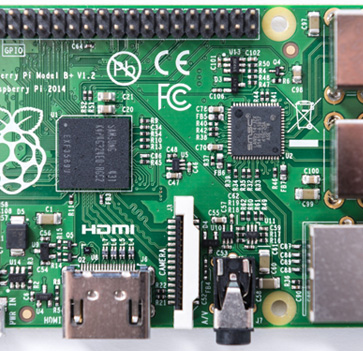
Definition
An embedded system can be defined as a control system or computer system designed to perform a specific task. Common examples of embedded systems include MP3 players, navigation systems on aircraft and intruder alarm systems. An embedded system can also be defined as a single purpose computer.
Embedded Technology is now in its prime and the wealth of knowledge available is mind blowing. Embedded systems usually only have a single task, or a very small number of related tasks that they are programmed to perform.
In general, an Embedded System
- Is a system built to perform its duty, completely or partially independent of human intervention.
- Is specially designed to perform a few tasks in the most efficient way.
- Interacts with physical elements in our environment, viz. controlling and driving a motor, sensing temperature, etc.

Development of Embedded Systems
Embedded processors span the range from simple 4-bit microcontrollers like those at the heart of a greeting card or children's toy, to powerful custom 128-bit microprocessors and specialized DSPs and network processors. Some of the products that include these chips run a short assembly program from ROM with no operating system; many more run real-time operating systems and complex multithreaded C or C++ programs; and it's also increasingly common to find variants of desktop-like operating systems based on Linux and Windows controlling more powerful devices that are still clearly embedded systems.
Embedded development makes up a small fraction of total programming. There are also a large number of embedded architectures. Virtually every electronic device designed and manufactured today is an embedded system, and virtually no first-world person is untouched by this technology. In fact, once you start looking for them, we're sure you can quickly find a few dozen embedded systems in your home.
Embedded systems frequently control hardware, and must be able to respond to them in real time. Failure to do so could cause inaccuracy in measurements, or even damage hardware such as motors. This is made even more difficult by the lack of resources available. Almost all embedded systems need to be able to prioritize some tasks over others, and to be able to put off/skip low priority tasks such as UI in favor of high priority tasks like hardware control.
Application of Embedded Systems
Most embedded systems are time critical applications meaning that the embedded system is working in an environment where timing is very important: the results of an operation are only relevant if they take place in a specific time frame. An autopilot in an aircraft is a time critical embedded system. If the autopilot detects that the plane for some reason is going into a stall then it should take steps to correct this within milliseconds or there would be catastrophic results.
Every home has several examples of embedded computers. Any appliance that has a digital clock, for instance, has a small embedded microcontroller that performs no other task than to display the clock. Modern cars have embedded computers onboard that control such things as ignition timing and anti-lock brakes using input from a number of different sensors.
The uses of embedded systems are virtually limitless, because every day new products are introduced to the market that utilizes embedded computers in novel ways. In recent years, hardware such as microprocessors, microcontrollers, and FPGA chips have become much cheaper. So when implementing a new form of control, it's wiser to just buy the generic chip and write your own custom software for it. Producing a custom-made chip to handle a particular task or set of tasks costs far more time and money.

Stages of Embedded System Development
Consulting
At this stage, we conduct research on subject of project feasibility taking into account market conditions and technical capabilities of the future product.
Specification
At this stage we detail product functionality, data format, architecture, etc. While every minor part of the embedded software/hardware project gets settled, we still remain open to new requests and suggestions from the customer's side.
Engineering Design
This stage involves both hardware designers and embedded software Engineers. Via successful cooperation, we jointly analyze manufacturing requirements, requirements to product durability, resources to be used, design and functionality, etc.
Prototype
A prototype lets the customer have a first look at the product, its features and functionality and therefore make a first evaluation. The prototype is fully tested for proper functioning to ensure it is ready to be incorporated in actual design and development.
Compliance Testing
This stage includes the embedded system safety testing, immunity to electromagnetic radiation and emissions. Once this phase is complete, the product can be certified. Additional testing may be required of the final product.
Preparation for Manufacture
The first iteration is a trial to define any remaining electronic design or software development problems. After a successful trial manufacturing run the product is ready for planned production.

Product Support
Once the product has been launched on the market, there will be a requirement for product support. We provide the respective technical personnel with all the necessary instructions and end-user guides.
Our integrated embedded technology solutions empower our customers to expedite the development process which helps them achieve short time-to-market coupled with exceptional return on investment.
Due to this the development of software for embedded technology is not only restricted for writing programs for the device alone, but the synchronization and communication also play a vital role.
Aanjaay Technologies has significant expertise in developing systems and embedded software solutions. This is a very specialized area of software development and requires a high degree of technical expertise. We have provided services to a large number of reputed clients of diversified backgrounds and industries
Aanjaay Technologies has been appreciably and prudently implemented Embedded Technology in textile industries for the following services:
- Fiber Preparation
- Spinning Preparation
- Ring Preparation
- Rotor Spinning
- Air - Jet Spinning
- Mill Information Systems
We have specialized in systems and following embedded software development
Domains
- Device Drivers
- Consumer Electronics
- Digital Video
- Networking/Telecommunications
- Security (Biometrics)
Technology
- Platforms
- Real Time Operations Systems
- Microcontrollers / Processors
- Languages:
- C,C++/Java
- Assembly languages
- Hardware Description Languages

